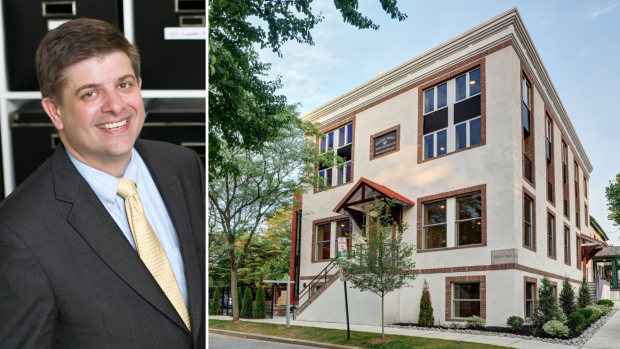New Jersey Future Blog
A New Housing Model for New Jersey
May 4th, 2021 by Guest Author
 By Joshua Zinder, AIA, NCARB, LEED AP
By Joshua Zinder, AIA, NCARB, LEED AP
2021 President, AIA New Jersey Chapter
Managing Partner, JZA+D
Living and working in Princeton, it’s easy to see what makes our town special. My architectural work here reflects our community’s desire to retain its unique character. But Princeton – like many municipalities across the state – needs to grow to stay economically viable, which ideally means adding density instead of sprawling outward. The word “density” often makes my neighbors worry, because they want to preserve the character of our tree-lined streets with detached single-family homes. Also, there is a pervasive fear that the arrival of lower-income residents could reduce property values – a fear arising in part from misconceptions about affordable housing.
Market-rate options are unattainable statewide for large swaths of the population, with teachers, first responders and other essential members of our communities priced out. What neighborhoods like mine need, and what architects are trying to identify and promote, is a new model for housing that addresses this “missing middle housing” gap. In brief, this term coined by urban planner Daniel Parolek refers to “house-scale buildings with multiple units in walkable neighborhoods.”
Growth is inevitable, and the alternative for most of our municipalities is economic and cultural stagnation. The desire to keep a developer from putting up a large, ungainly apartment complex on a quiet residential corridor is entirely understandable, but the most common alternative is locating such developments in areas far from town centers, which fails to achieve the goal: walkable, sustainable, affordable, and diverse communities that can sustain economic growth. These apartment complexes are often the only entry-level option for low-to-moderate income renters moving to take essential jobs in places like Princeton. Ironically, even these commonly face opposition to approvals, thanks in part to high court rulings.
These qualities – walkable, sustainable, diverse – are typically associated with the best of urban living. City dwellers, especially younger ones, appreciate the socially dynamic and vibrant qualities of the urban lifestyle and seek some measure of them when they move to a smaller town. And residents of smaller towns appreciate those qualities, too. Who doesn’t like having a greater variety in options for dining, shopping, and entertainment? These folks, our neighbors, just need reasons to stop resisting growth.
As proponents of addressing missing middle housing, many of my colleagues in New Jersey’s architecture profession are looking for opportunities to devise creative, attractive solutions for promoting density and affordability. As 2021 President of AIA-New Jersey, our statewide professional organization, I have made promoting this effort a priority. Our goal is to identify and promote strategies for adding attainable housing units, weaving them into the fabric of our neighborhoods and leaving no tool left unused in the toolbox.
Here in Princeton several solutions have emerged – many of them approved and moving forward or completed – each carefully conceived to retain or even enhance the existing neighborhood character and offering a view of Princeton’s sustainable future. A ten-unit mixed-income development has opened in a former Masonic meeting house, the interior completely transformed while the historic façade was restored and the visual impact on the block minimized. Nearby a six-unit residence will add several floors to a one-story commercial structure, with a profile that steps back from the street as it rises and a new restaurant or retail amenity on the first floor, adding social dynamism as well as much-needed residential units.
Other strategies include redeveloping existing properties to add accessory dwellings or multi-unit structures on the rear of lots, retaining the familiar neighborhood feel. Downtown Princeton has seen recent activity in mixed-use corridors to redevelop residential units above street-level shops, activating our most walkable neighborhood.
And just a few blocks away plans are under way for a major municipally oriented development that will combine a variety of building heights and architectural styles. This optimal missing-middle housing mix will sit within a campus that will be open and permeable to pedestrian traffic, with publicly accessible spaces around the buildings offering community value. This campus will create a bridge between a neighborhood of single-family detached homes on one side and the historic Witherspoon-Jackson district (largely two-family houses) on the other, adding energy and walkability to a large swath of the town center while reflecting the area’s history and culture.
In the meantime, architects and professionals in related fields are working on ways to streamline how these solutions get implemented. Outdated zoning processes should be replaced with more responsive and nimble alternatives, allowing development to move more quickly and to everyone’s advantage.
The existing fabric of our cities and towns can and should fill the missing middle, rather than building midrise developments that lack any sense of scale or context or are located outside of municipal centers. The latter has served us poorly so far, while the former is a path to sustainable, successful economic growth throughout New Jersey.
Joshua Zinder, AIA, NCARB, LEED AP BD+C is managing partner of design firm JZA+D in Princeton and 2021 AIA-New Jersey president. Architects are creative professionals, educated, trained, and experienced in the art and science of building design, and licensed to practice architecture. Their designs respond to client needs, wants and vision, protect public safety, provide economic value, are innovative, inspire and contribute positively to the community and the environment. Founded in 1857, the American Institute of Architects (AIA) consistently works to create more valuable, healthy, secure, and sustainable buildings, neighborhoods, and communities. Through a dynamic network of more than 250 chapters and more than 95,000 member architects and design professionals, the AIA advocates for public policies that promote economic vitality and public wellbeing. Members adhere to a code of ethics and conduct to ensure the highest professional standards. The AIA provides members with tools and resources to assist them in their careers and business as well as engaging civic and government leaders and the public to find solutions to pressing issues facing our communities, institutions, nation, and world. The organization’s local chapter, AIA New Jersey, has served as the voice of the architectural profession in the Garden State since 1900. Based in Trenton, AIA New Jersey has over 2,000 members across six sections. For more information, please visit http://www.aia-nj.org
Related Posts
 July 17, 2023 Common Ground Emerges on Affordable Housing Solutions
July 17, 2023 Common Ground Emerges on Affordable Housing Solutions July 30, 2024 New Jersey’s Housing Landscape: The Mount Laurel Doctrine and the Search for the Missing Middle
July 30, 2024 New Jersey’s Housing Landscape: The Mount Laurel Doctrine and the Search for the Missing Middle September 21, 2022 Next Steps for Warehouse Planning – and Regional Planning More Broadly
September 21, 2022 Next Steps for Warehouse Planning – and Regional Planning More Broadly July 11, 2022 The State of New Jersey’s Housing Market: We Need More
July 11, 2022 The State of New Jersey’s Housing Market: We Need More July 11, 2022 State Agencies Shape Infrastructure Programs to Address 21st Century Challenges
July 11, 2022 State Agencies Shape Infrastructure Programs to Address 21st Century Challenges
Posted in Community Design, Development and Redevelopment, Housing and Equity, Redevelopment, Uncategorized
Tags: cities and towns, Development, guest author, Joshua Zinder, missing middle, Redevelopment, walkable communities, Zoning
Comments are closed.











